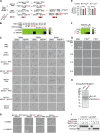Construction of Candida albicans Strains with ATP-Analog-Sensitive Protein Kinase A and Hog1
- PMID: 37039635
- PMCID: PMC10286698
- DOI: 10.1128/msphere.00095-23
Construction of Candida albicans Strains with ATP-Analog-Sensitive Protein Kinase A and Hog1
Abstract
Candida albicans is an opportunistic human fungal pathogen and a member of the mucosal microbiota. To survive in the host and cause disease, C. albicans utilizes several virulence traits, including the ability to respond and adapt to diverse stressors, as well as the morphogenetic switch between yeast and filamentous morphologies. While complex cellular circuitry governs these virulence attributes, the following two kinase-mediated signaling pathways play particularly critical roles in controlling these processes: the Hog1 mitogen-activated protein kinase (MAPK) cascade and the protein kinase A (PKA) pathway. Here, we describe the construction of C. albicans strains harboring substitutions in the ATP-binding pockets of Hog1 and the catalytic subunits of PKA, Tpk1, and Tpk2 to render their activities sensitive to the addition of bulky ATP analogs. Specifically, inhibition by the ATP analog 1NM-PP1 resulted in phenotypes characteristic of the corresponding homozygous deletion mutants for each kinase gene. These strains represent a toolset for the rapid and specific inhibition of PKA and Hog1 kinase activity to further understand their roles in regulating C. albicans morphogenesis and stress responses. IMPORTANCE As an opportunistic pathogen in humans, the fungus Candida albicans relies on virulence traits to cause disease. They include the ability to transition from yeast to filamentous morphologies and the ability to grow in diverse environmental stress conditions, including nutrient limitation, as well as osmotic and heat shock. Previous work identified the following two kinases that play a critical role in regulating these responses: Hog1 and PKA. Here, we generated versions of each kinase that are sensitive to inhibition by a bulky ATP analog, 1NM-PP1. In the presence of the analog, kinase activity is inhibited rapidly and specifically, facilitating the analysis of both kinases in regulating C. albicans morphogenesis and stress responses. Together, these strains represent an important toolset to further our understanding of C. albicans biology and virulence.
Keywords: 1NM-PP1; ATP; Candida albicans; Hog1; genetic resource; protein kinase A.
Conflict of interest statement
The authors declare a conflict of interest. L.E.C. is a co-founder and shareholder in Bright Angel Therapeutics, a platform company for development of novel antifungal therapeutics. L.E.C. is a Science Advisor for Kapoose Creek, a company that harnesses the therapeutic potential of fungi.
Figures


Similar articles
-
Exploring the differential localization of protein kinase A isoforms in Candida albicans.mSphere. 2025 Mar 25;10(3):e0103724. doi: 10.1128/msphere.01037-24. Epub 2025 Feb 25. mSphere. 2025. PMID: 39998251 Free PMC article.
-
Adenylyl Cyclase and Protein Kinase A Play Redundant and Distinct Roles in Growth, Differentiation, Antifungal Drug Resistance, and Pathogenicity of Candida auris.mBio. 2021 Oct 26;12(5):e0272921. doi: 10.1128/mBio.02729-21. Epub 2021 Oct 19. mBio. 2021. PMID: 34663094 Free PMC article.
-
The Hog1 MAP kinase controls respiratory metabolism in the fungal pathogen Candida albicans.Microbiology (Reading). 2009 Feb;155(Pt 2):413-423. doi: 10.1099/mic.0.023309-0. Microbiology (Reading). 2009. PMID: 19202089
-
Multiple roles and diverse regulation of the Ras/cAMP/protein kinase A pathway in Candida albicans.Mol Microbiol. 2019 Jan;111(1):6-16. doi: 10.1111/mmi.14148. Epub 2018 Nov 4. Mol Microbiol. 2019. PMID: 30299574 Review.
-
Stress adaptation in a pathogenic fungus.J Exp Biol. 2014 Jan 1;217(Pt 1):144-55. doi: 10.1242/jeb.088930. J Exp Biol. 2014. PMID: 24353214 Free PMC article. Review.
References
MeSH terms
Substances
Grants and funding
LinkOut - more resources
Full Text Sources
Research Materials
